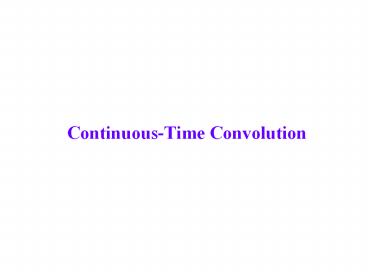Continuous-Time Convolution - PowerPoint PPT Presentation
Title:
Continuous-Time Convolution
Description:
Continuous-Time Convolution Impulse Response Impulse response of a system is response of the system to an input that is a unit impulse (i.e., a Dirac delta functional ... – PowerPoint PPT presentation
Number of Views:112
Avg rating:3.0/5.0
Title: Continuous-Time Convolution
1
Continuous-Time Convolution
2
Impulse Response
- Impulse response of a system is response of the
system to an input that is a unit impulse (i.e.,
a Dirac delta functional in continuous time) - When initial conditions are zero, this
differential equation is LTI and system has
impulse response
3
System Response
- Signals as sum of impulses
- But we know how to calculate the impulse response
( h(t) ) of a system expressed as a differential
equation - Therefore, we know how to calculate the system
output for any input, x(t)
4
Graphical Convolution Methods
- From the convolution integral, convolution is
equivalent to - Rotating one of the functions about the y axis
- Shifting it by t
- Multiplying this flipped, shifted function with
the other function - Calculating the area under this product
- Assigning this value to f1(t) f2(t) at t
5
Graphical Convolution Example
- Convolve the following two functions
- Replace t with t in f(t) and g(t)
- Choose to flip and slide g(t) since it is simpler
and symmetric - Functions overlap like this
t
6
Graphical Convolution Example
- Convolution can be divided into 5 parts
- t lt -2
- Two functions do not overlap
- Area under the product of thefunctions is zero
- -2 ? t lt 0
- Part of g(t) overlaps part of f(t)
- Area under the product of thefunctions is
7
Graphical Convolution Example
- 0 ? t lt 2
- Here, g(t) completely overlaps f(t)
- Area under the product is just
- 2 ? t lt 4
- Part of g(t) and f(t) overlap
- Calculated similarly to -2 ? t lt 0
- t ? 4
- g(t) and f(t) do not overlap
- Area under their product is zero
8
Graphical Convolution Example
- Result of convolution (5 intervals of interest)
No Overlap
Partial Overlap
Complete Overlap
Partial Overlap
No Overlap
y(t)
6
t
0
2
4
-2































